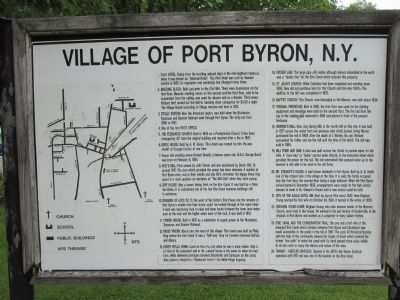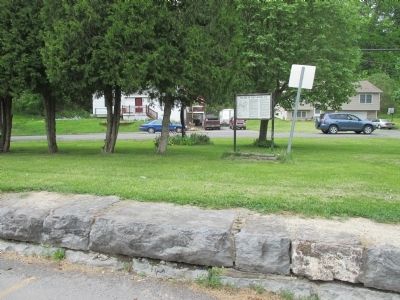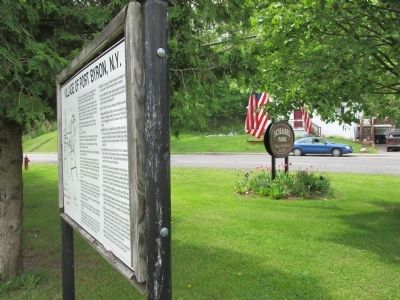Port Byron in Cayuga County, New York — The American Northeast (Mid-Atlantic)
Village of Port Byron
1. Park Hotel: Dates from the bustling railroad days in the mid-eighteen hundreds when it was known as "National Hotel". The Park Hotel was built by Samuel Lamkin in 1835. Its reputation and ownership has changed many times.
2. Masonic Block: Built just prior to the Civil War. There were businesses on the first floor, Mason meeting rooms on the second and the third floor, said to be suspended from the ceiling, was used for dances and as a theater. Third owner, Richard Hoff, rented out the Hall to traveling show companies for $5.00 a night. The Village Board according to Village minutes, met here in 1851.
3. Trolly [sic] Station: Now the American Legion, was built when the Rochester, Syracuse and Eastern Railroad went through Port Byron. The trolly ran from 1908 to 1931.
4. Site of the first Post Office.
5. The Federated Church: Built in 1843 as a Presbyterian Church. It has been enlarged by 20' from the original building and repaired after a fire in 1887.
6. Brick House: Built by A.W. Green. The street was named for him. He was sheriff of Cayuga County at one time.
7. House still standing where Richard Bonelli, a famous opera star (A.K.A. George Bunn) was born on February 6, 1884.
8. Wilt's Mill: First owned by John Tanner and was purchased by Delvin Wilt, Sr. around 1917. The dam which provided the power has been removed. A number of Port Byron men, now in their middle and late 60's remember the happy times they spent in a room upstairs as members of "The Mill Club" when they were young.
9. Erie House: Was a tavern facing front on the Erie Canal. It was built by a Peter Van Detto. It is considered one of the few Erie Canal business buildings still in existance.
10. Remains of Lock 52: To the west of Van Detto's Erie House are the remains of Port Byron's double lock (two boats could be locked through at the same time). A lock was necessary here to raise and lower boats between the lower level water east of the lock and the higher water west of the lock. It was built in 1851.
11. Power House: Built in 1907 as a substation to supply power to the Rochester, Syracuse, and Eastern Railroad.
12. Kings Tavern: About one mile west of the village. This tavern was built by Philip King before the Erie Canal. It was a "half-way" stop for travelers between Buffalo and Albany.
13. Henry Wells Home: Lived on this property when he was a shoe maker. Only a portion of the basement wall in the present house is the same as when he lived here. Wells delivered packages between Rochester and Syracuse on the canal, then joined a friend from Weedsport to form Well-Fargo Express.
14. Feeder Line: The large pipe still visible although almost embedded in the earth was a "feeder line"
for the Erie Canal which crossed this property.
15. St. John's Church: While Catholics had been organized and meeting since 1858, they did not purchase land for this Church until the late 1890's. The addition to the left was completed in 1972.
16. Baptist Church: This Church, now belonging to the Masons, was built about 1834.
17. Original Firehouse: Built in 1890, the first floor was used for fire fighting equipment and meetings were held on the second floor. The fire bell from the top of the building was removed in 1988 and placed in front of the present firehouse.
18. Warren's Mill: Now Day Spring Mill, is the fourth mill on this site. It was built in 1877 across the outlet from two previous mills which burned. Irving Warren purchased the mill in 1909. After the death of I. Warren, his son, Richard succeeded his father and ran the mill until the time of his death. The mill was sold in 1984.
19. Mill Pond and Dam: A dam was built across the Outlet to provide water for the mills. A "race-way" or "flume" carried water directly to the horizontal wheel which provided the power for the mill. The old waterwheel that pumped water up to the resevoir [sic] is still able to be seen in the old flume.
20. Dr. Stewart's House: A well known landmark in Port Byron. Built by D.B. Smith one of the richest men in the village at the time. It is said, the family occupied only the first floor, the second floor being a large ballroom. When the Port Byron school burned in December 1935, arrangements were made for the high school classes to meet in Dr. Stewart's House until a new school could be built.
21. Site of the Eagle Hotel Inn: Built by James Pine about 1820. Here Brigham Young married his first wife on October 24, 1824. It burned in the winter of 1856.
22. Brigham Young Home: Brigham Young, who later became leader of the Mormon Church, once lived in this house. He worked in the pail factory at Haydenville, in the drydock in Port Byron and worked as a carpenter in many Auburn homes.
23. Erie Canal and the Conservation Trail: The one and a half mile of the enlarged Erie Canal which remains between Port Byron and Centerport was made accessible to the public in the fall of 1987. The Lock 52 Historical Society with the help of the community cleared the tangle of brush which covered the former "tow path" to make the canal with it's [sic] hand placed stone sides visible to all who wish to enjoy the history and nature of the area.
24. Tanner - Shelter Drydock: Opened in the 1870's the Tanner DRydock operated until 1917 and was one of the busiest on the Erie Canal.
Topics. This historical marker is listed in these topic lists: Churches & Religion • Industry & Commerce • Railroads & Streetcars • Waterways & Vessels. A significant historical month for this entry is February 1907.
Location. 43° 2.247′ N, 76° 37.191′ W. Marker is in Port Byron, New York, in Cayuga County. Marker can be reached from Utica Street (New York State Route 31) ¼ mile east of Main Street (New York State Route 38). Marker is in Schasel Park facing the parking lot. Touch for map. Marker is in this post office area: Port Byron NY 13140, United States of America. Touch for directions.
Other nearby markers. At least 8 other markers are within walking distance of this marker. The Empire State Trail at Port Byron (a few steps from this marker); Abraham Lincoln (within shouting distance of this marker); Tanner's Dry Dock (within shouting distance of this marker); A Metaphor for Change (within shouting distance of this marker); Port Byron (approx. ¼ mile away); Amos S. King (approx. ¼ mile away); Brigham Young (approx. ¼ mile away); Henry Wells (approx. 0.6 miles away). Touch for a list and map of all markers in Port Byron.
Also see . . .
1. Richard Bonelli - Wikipedia. (Submitted on May 22, 2015, by Anton Schwarzmueller of Wilson, New York.)
2. Henry Wells - Wikipedia. (Submitted on May 22, 2015, by Anton Schwarzmueller of Wilson, New York.)
Credits. This page was last revised on June 16, 2016. It was originally submitted on May 22, 2015, by Anton Schwarzmueller of Wilson, New York. This page has been viewed 660 times since then and 67 times this year. Photos: 1, 2, 3. submitted on May 22, 2015, by Anton Schwarzmueller of Wilson, New York.


